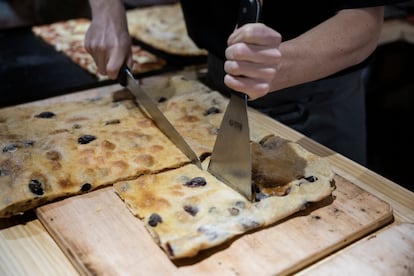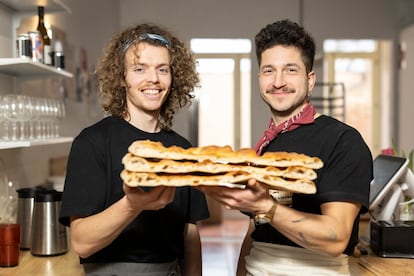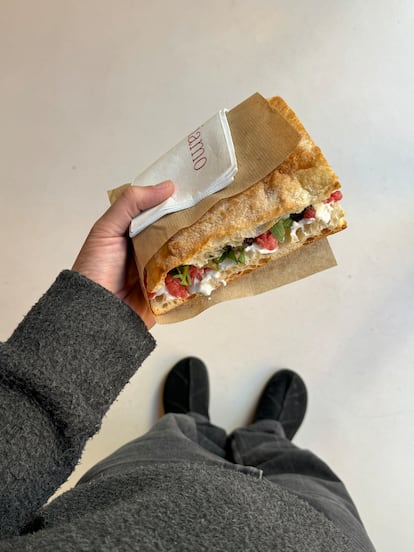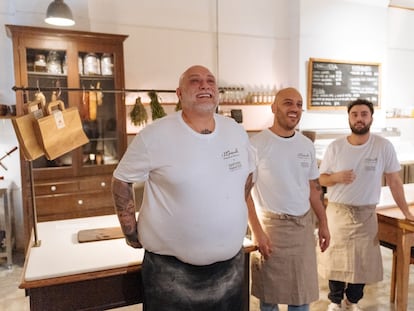Can focaccia dethrone pizza?
It’s here to stay. Young bakers hail the flatbread as a star that is leading a peaceful and delicious revolt

Focaccia is revered among Italians. The dish originated in the lower levels of the Roman Empire as a thin, crusty bread known as pania focaccia. This type of flatbread quickly spread throughout Europe and ignited a culinary phenomenon in Italy that endures to this day.
It’s important to note that focaccia, like many traditional dishes, has evolved over time in Italy, with different regions vying to assert their own version. This culinary rivalry presents a delightful array for newcomers, allowing them to savor a variety of recipes. Among the most renowned are Salentina, Baremo, Calabrese, Sardinian, Barese, Seminesse and Palermitana. But there are many other variations, reflecting the diverse dialects and regions of Italy. While each recipe differs in dough thickness, baking method and ingredients, they all trace their roots back to the original focaccia.
It was inevitable that such a popular food would make its way to other countries, including Spain, where it’s the star attraction at restaurants like Focacciamo in Madrid and Forno Bomba in Barcelona. Focaccia has become so popular that Focacciamo is already eyeing a second location in Madrid’s Chamberí neighborhood, while Forno Bomba has recently launched its debut site. Naturally, their focaccias boast distinct flavors, but certain elements remain constant whether in Italy, Spain or the United States.

Forno Bomba recently opened its doors in the Sants neighborhood, a Barcelona enclave noted for its gastronomy. The restaurant’s sourdough bread and amazing cinnamon rolls are just the prelude to a dish they have been perfecting for a long time — the divine focaccia. Made by chefs Francesco Gottardo and Alberto Montobbio, Forno Bomba’s focaccia is already a must-try, luring in hungry people on their way home. “As Italians living abroad, we must tell you that it’s not just about Neapolitan pizza and those towering focaccias bursting with toppings,” said Gottardo. “No, in Italy, we have quite a few pizza and focaccia varieties. With Forno Bomba, our mission is all about spreading culinary knowledge and showing folks the diverse world of focaccia, whether it’s Puglia’s version or Genoa’s twist.”
“We spotted a market opportunity, a chance to bring something unique that Madrid hadn’t seen before. We enjoy using stracchino (soft Italian cow’s-milk cheese), pistachio cream, bresaola (dry salted beef), and fior di latte (fresh mozzarella), along with various sausages, creams and sauces. Our recipe puts a twist on the traditional one, featuring a lighter focaccia with extended fermentation and creative ingredient combinations,” said Roberto Violante. With Giacommo Garini and Santiago Bedoya, Violante runs Focacciamo in Madrid. Violante is from Puglia, Garini from Milan, and Bedoya from Bolivia — the result is a tasty blend of Italian varieties.
For Montobbio, focaccia deserves respect, so he takes a deep breath before singing its praises. “There’s so much to talk about, but let’s keep it short: focaccia is magic! It’s a simple bread dough but so much more. Different regions have their own versions — in Genoa, it’s thin with loads of oil and salt. In Puglia, it’s thicker and made with yellow semolina flour topped with tomato, oregano and tons of olive oil. The variety is mind-blowing given how simple and tasty it is. In my homeland, we have more focaccia varieties than bread — ten types of focaccia and just two types of bread! You can dip it in cappuccino in the morning, have one kind for lunch and another for dinner. Basically, a day of focaccia feasting. Makes sense, doesn’t it?” he laughs.

The dish is also appealing because it’s inexpensive: a basic focaccia costs about €4 ($4.35) at Forno Bomba and €9-€12 ($9.80-$13) at Focacciamo, depending on portion size and toppings. The simplicity of focaccia and its delicious ingredients are what make it so popular.
One of the mysteries about focaccia is the dough, and each baker has their own recipe. Violante said, “We have a 24-hour fermentation process using two types of flour. It produces a very light, digestible dough that’s crispy on the outside and spongy on the inside.” But that’s all Violante would tell us. Gottardo offered a few more details about their dough. “We make a wet dough with flour that’s part whole wheat and part sourdough. We let it rise all night and then bake it for about 20 minutes at 250-260 degrees Celsius [480°-500° Fahrenheit].” Gottardo also cleared up another confusion shared by many. “The difference between focaccia and [thin] Roman pizza is that focaccia has more oil and pizza uses about a third of the dough that focaccia has. Thin-crust pizza is baked by giving it a quick blast of high heat to make it crispy.”

In Barcelona, The Bakers in the Fortpienc neighborhood, crafts a delectably classic focaccia on weekends. Alongside Pà de kilo, another local bakery, both are esteemed in Barcelona’s culinary scene. Over in Madrid, Il Morso boasts a dedicated focaccia following featuring Italian delights like porchetta (pork belly), and even one with roasted potatoes. Madrid locals also flock to Panadario, renowned for its focaccia topped with tomato and cheese from Zucca (in Valladolid), zucchini and pesto. Meanwhile, in Valencia, Acqua e farina offers an array of focaccias as appetizers, providing a refined dining experience compared to the more common street-style options.
Surely, in the time it takes to read this article, someone is getting ready for a new focaccia adventure not far from your home. Focaccia has arrived, as they say in show business. And it’s here to stay.
Sign up for our weekly newsletter to get more English-language news coverage from EL PAÍS USA Edition.
Tu suscripción se está usando en otro dispositivo
¿Quieres añadir otro usuario a tu suscripción?
Si continúas leyendo en este dispositivo, no se podrá leer en el otro.
FlechaTu suscripción se está usando en otro dispositivo y solo puedes acceder a EL PAÍS desde un dispositivo a la vez.
Si quieres compartir tu cuenta, cambia tu suscripción a la modalidad Premium, así podrás añadir otro usuario. Cada uno accederá con su propia cuenta de email, lo que os permitirá personalizar vuestra experiencia en EL PAÍS.
¿Tienes una suscripción de empresa? Accede aquí para contratar más cuentas.
En el caso de no saber quién está usando tu cuenta, te recomendamos cambiar tu contraseña aquí.
Si decides continuar compartiendo tu cuenta, este mensaje se mostrará en tu dispositivo y en el de la otra persona que está usando tu cuenta de forma indefinida, afectando a tu experiencia de lectura. Puedes consultar aquí los términos y condiciones de la suscripción digital.
More information
Archived In
Últimas noticias
From Andorra to Gibraltar, a black market for Ozempic exploits its success: ‘They’re the most sought-after products in the world’
Magnets in their heads: How some animals guide themselves using the Earth’s magnetic field
From Hungary’s Orbán to Chile’s Kast: How Trump helps turbo charge the far right
The brief rise and retreat of Generation Z in Mexico
Most viewed
- Why we lost the habit of sleeping in two segments and how that changed our sense of time
- Trump’s obsession with putting his name on everything is unprecedented in the United States
- Charles Dubouloz, mountaineering star, retires at 36 with a farewell tour inspired by Walter Bonatti
- Venezuela faces its most tense Christmas yet
- The Florida Keys tourist paradise is besieged by immigration agents: ‘We’ve never seen anything like this’











































